Creating a woodland garden provides you with enchanting spaces that bring a sense of tranquility and magic to your outdoor environment. A woodland garden transforms your outdoor space into a haven of serenity. The thoughtful arrangement of trees, shrubs, and ground covers brings in the ambience and layered structure of a forest. You’ll love the lush backdrop that changes with the seasons.
Whether you have a spacious yard or a compact corner, the charm of a woodland garden will transport you to a natural retreat, right in the comfort of your own home.
But even more, woodland garden contributes to the ecological well-being of your surroundings as well. By using native plants, you provide essential habitats for local wildlife, offering habit and support of delicate ecosystems. The shade-tolerant ferns, vibrant wildflowers, and carefully selected vines create a harmonious environment where birds, insects, and small mammals can thrive.
Importance of Woodland Garden Plants, Bushes and Trees for Ecological Balance:
We contribute to the support of our local insects, birds and bees, along with other animals and microorganisms vital to a healthy planet when we choose native species and other garden mates that attract, feed and shelter our communities of local wildlife. We also support our own mental health when we provide ourselves a welcoming, lovely serene outdoor area to restore ourselves.
Woodland gardening is a beautiful method of gardening that enhances your property’s ability to provide that support and offers you a lovely garden atmosphere while your at it.
- Biodiversity Support: Different plants, bushes and trees support diverse communities of insects, birds, mammals, and fungi, contributing to overall biodiversity.
- Nutrient Cycling: Decomposing plant material adds organic matter to the soil, supporting nutrient cycling and maintaining soil fertility.
- Carbon Sequestration: Trees play a crucial role in sequestering carbon dioxide, helping offset CO2 accumulation and provide balance to the ecosystem.
- Water Regulation: Woodland plants contribute to water regulation, preventing soil erosion and influencing local hydrological cycles.
While specific plant species may vary by region, the key is to emphasize native species that have co-evolved with the local ecosystem. Native plants are better adapted to local climate, soil conditions, and provide essential resources for native wildlife. Conservation and restoration efforts often focus on planting native species to enhance and maintain ecological balance.
Organic Garden Only!
You MUST use organic gardening products and methods when your purpose is to attract and support insects, birds, butterflies and other wildlife. Use of conventional pesticides is counter productive to life support of these species.
There is no point in attracting wildlife when your woodland garden is full of toxins. It’s a sad result indeed. Woodland gardens are well suited to rustic, and somewhat weedy appearances. So focus on organic, healthy gardening. Your forest friends will thank you!
Woodland Garden Design:
A Woodlands garden can be designed to fit any yard space. You may have to limit some of the elements we discuss or even omit some to make your situation work out best for you if your space is small. However, the basic concept of creating a viable space to support and enjoy nature in your immediate surroundings will work in any yard space.
Remember to consider the specific light and soil requirements of each plant when planning your woodland garden. Creating layers of different plant heights and textures results in a gorgeous, dynamic landscape throughout the year. Plan for all four seasons when building your garden design. Choose flora that will provide color, texture and wildlife support all year long.
In the following section we offer tips for small spaces and large lot considerations as well.
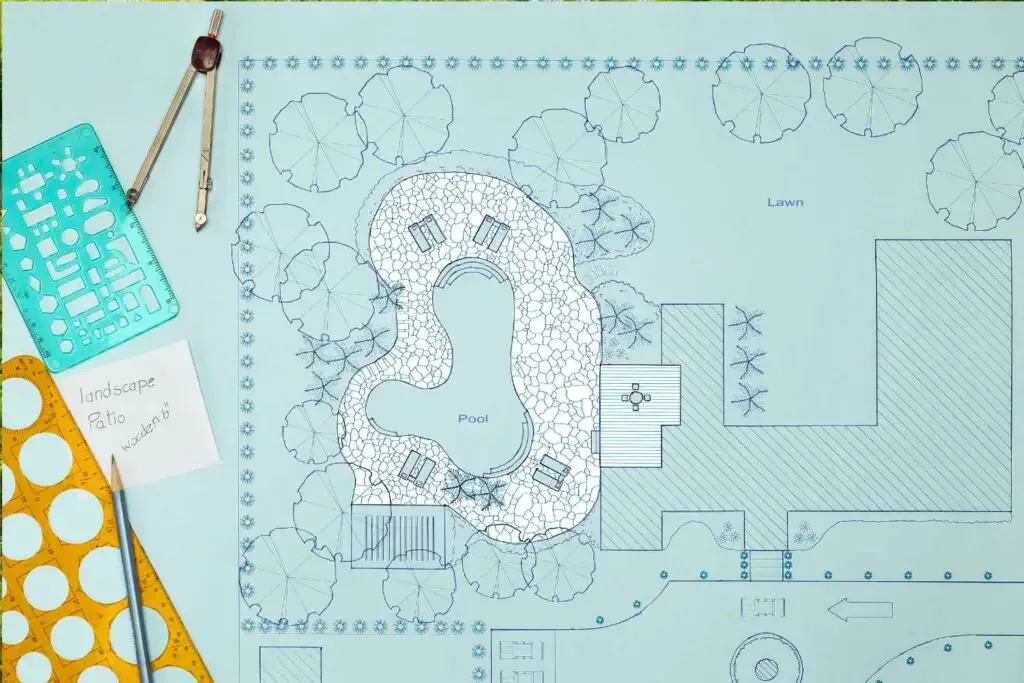
We suggest you work with a good landscaper to finalize your plan and set it in motion. A professional will also take care of the things you don’t think of or cannot manage without help. The drainage and hard scaping come to mind. Landscaping from a raw lot requires thought and careful planning.
Enhancing an existing garden is much easier and can be done over time with a small budget.
Vital Elements to Create A Woodland Garden:
We have listed below trees, bushes, other plants and enhancements you will want to consider putting into your woodlands garden design. There are many ways to make your woodsy garden a vital addition to your neighborhood fauna and a place you will Revel in.
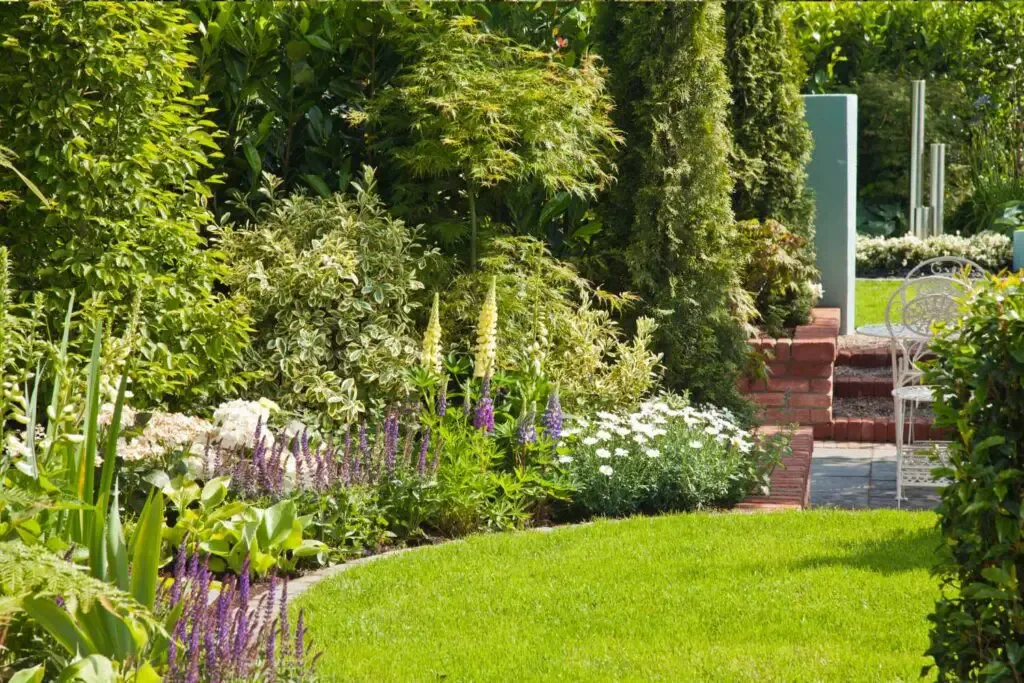
Clearing:
Position a level space where you are most going to enjoy and use it. In all yards we need a space where we recreate or socialize. this is usually located near the home in the back where it can offer privacy and quiet.
It is from this place you immerse yourself in your woodland escape. Make sure you can see it from your home windows but keep it away from traffic noise and busy foot traffic areas. This is a resting or recreating area. You want to enjoy being surrounded by your woodland dreamscape without noisy distractions.
While all that is true, this can also be a busy area where cooking and games happen. Create the space that works best for your lifestyle. This could be a circular (or any shape) lawn, barbecue area, complete outdoor kitchen, pond patio, or outdoor seating area surrounded by your woodland trees, bushes and flowers.
We suggest you design this area to work harmoniously with your woodlands garden. Bring them together in a pleasing design so you will enjoy both places.
Woodland Pathways:
Be sure to design meandering pathways that wind through the garden. Use natural materials like wood chips, crushed rock or stepping stones to maintain a natural feel. In a small space add twists and bends in the path with focal points along the way to create an interesting and visually expansive look to your small woodland. And make sure all the areas are wheel barrow accessible to allow for clean up, repairs and pruning as needed.

In a larger landscape, the paths need to be wider and stand up to bad weather. These paths will provide necessary access to remote parts of the woodland that require large vehicles like trucks and tractors to navigate for tree and branch removal, future landscaping, transplanting and other large scale maintenance projects. Plan for this along with enjoying these paths as walking space, hiking with dogs, or even horse riding as appropriate.
You may need fencing or gates as well for both large and small lots to protect your privacy, kids and pets and to provide security for your property.
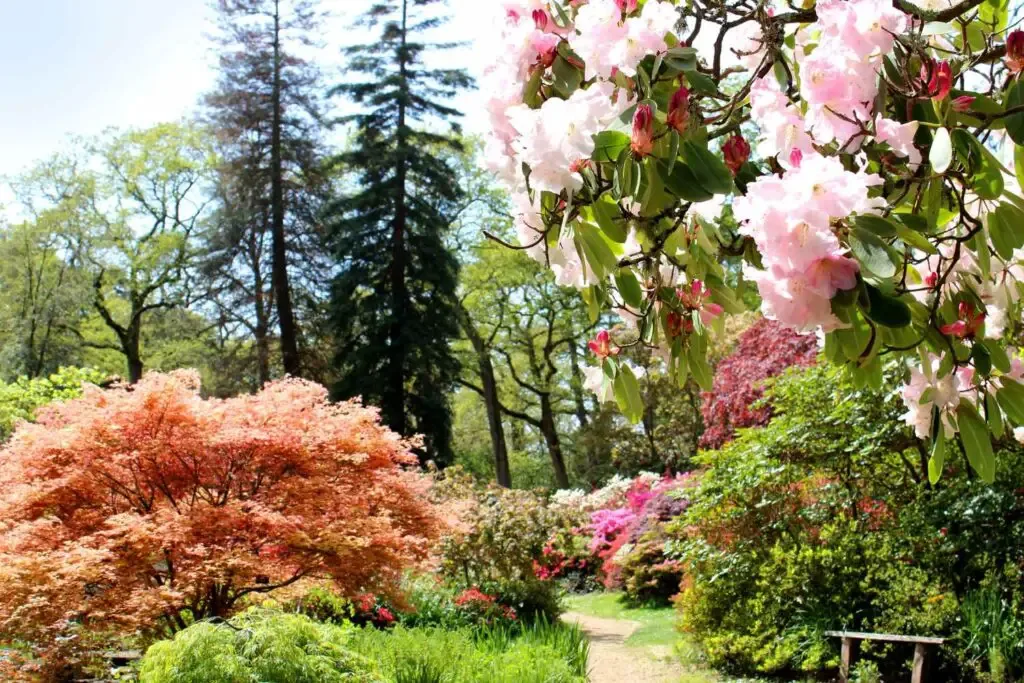
Putting In the Flora:
Trees:
Large trees like tall evergreen Pine, Fir and Cedars or the large deciduous trees like black walnut, poplars, native trees or large leaf maples are best suited to properties with the room to handle their size. If you have a large lot or acreage, be sure to include large canopy trees. Many native trees will populate themselves and create a wood lot for you.
- Importance:
- Canopy Structure: Trees provide the overarching canopy structure that shapes the forest environment. The canopy offers shade, regulates temperature, and influences humidity levels.
- Habitat: Large trees create nesting sites and habitat for numerous species of birds and mammals.
- Photosynthesis: Trees perform photosynthesis, converting carbon dioxide into oxygen and providing a vital component of the Earth’s oxygen supply.
TIP: In a small yard, Keep the trees lower than your gutter line to reduce roof and gutter maintenance. Also watch out for tree roots getting too close to the foundation of your home. Trees are lovely. They provide year round color and structural interest as well as giving excellent shade and habitat for local creatures. Just be sure to scale them correctly to your yard space.
- Plant a mix of appropriate native trees around the perimeter of your garden, providing a natural canopy. Consider species like oak, maple, or dogwood.
- Common in many woodlands,Large leaf maple, black Walnut, and Chestnut are valuable for wildlife food and shelter. Tall evergreen trees like firs, pine and cedars make great wind breaks, shelter and nesting trees. Maples, alders and other deciduous trees are wonderful additions to the woodland garden and provide amazing Fall color.:
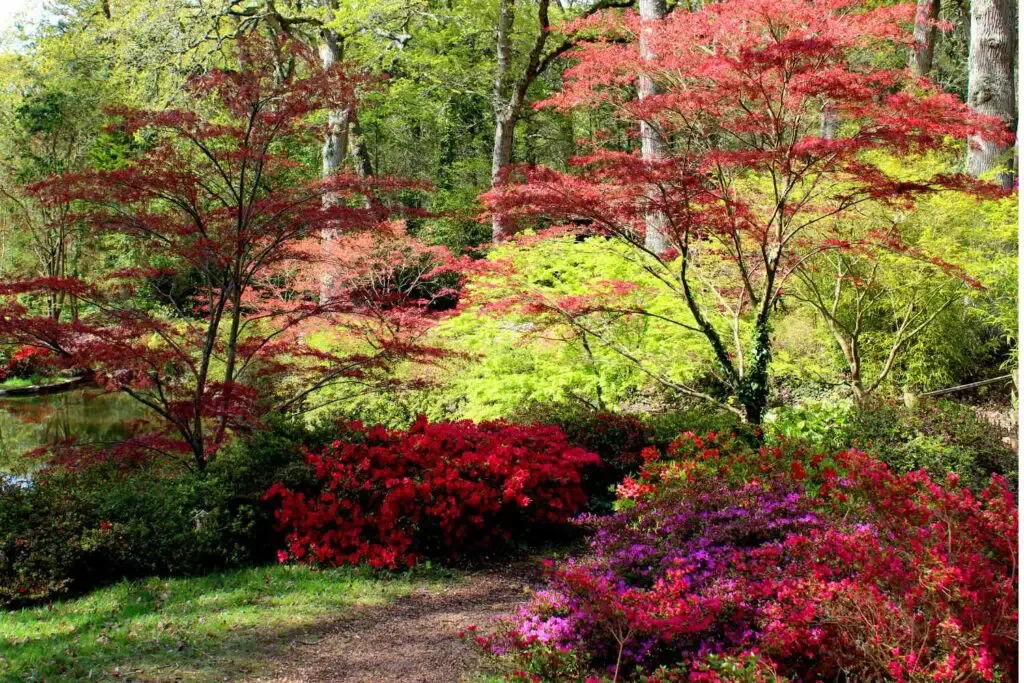
UnderstoryTrees For The Woodland Garden:
Smaller trees are more appropriate if you have only a small lot to work with. Understory trees also work well mixed into a woodland garden with towering large trees overhead. Here are some favorites.
- Dogwood (Cornus spp.): Some dogwood species, such as Cornus florida (flowering dogwood), are well-suited to woodland settings. They provide beautiful spring blooms.
- Serviceberry (Amelanchier spp.): These small trees or large shrubs offer delicate white flowers in spring and colorful berries in summer.
- Redbud (Cercis spp.): Redbuds, like Cercis canadensis, produce striking pink or purple flowers in early spring.
- Japanese Maple (Acer palmatum): Many varieties of Japanese maple have attractive foliage and can thrive in the dappled shade of a woodland garden.
- Oakleaf Hydrangea (Hydrangea quercifolia): This deciduous shrub has large, oak-like leaves and produces cone-shaped flower clusters.
Shrubs:
Shrubs provide shelter from predators and bad weather, pollen for pollinators and food for birds in winter. They are also lovely in several seasons of the year. Choose shrubs that attract your local wildlife and give you a beautiful compliment to your overall design for all seasons.
- Importance:
- Understory Habitat: Shrubs form the understory layer, offering habitat for birds, insects, and small mammals.
- Food Sources: Many shrubs produce berries, fruits, or seeds that serve as important food sources for wildlife.
- Erosion Control: Shrub roots help stabilize soil, preventing erosion.
Shrubs For Woodland Gardens:
- Rhododendron and Azalea (Rhododendron spp.): These evergreen or deciduous shrubs offer a burst of color in spring with their showy flowers.
- Mountain Laurel (Kalmia latifolia): Known for its clusters of cup-shaped flowers, mountain laurel is an attractive evergreen shrub.
- Fothergilla (Fothergilla spp.): This deciduous shrub produces fragrant spring flowers and has attractive fall foliage.
- Pieris (Pieris spp.): Also known as andromeda, pieris features cascading clusters of bell-shaped flowers in early spring.
- Camellia (Camellia spp.): Evergreen camellias produce elegant flowers in various colors and bloom during the cooler months.
- Red and Yellow twig Dogwood (Cornus spp.) Excellent fall and winter color. Produce berries that feed song birds.
Understory Shrubs: TIPS
Bring in bushes that do well in your area and attract local birds and other tree nesting residents. Bushes with winter food sources, spring and fall color are particularly valuable inclusions. Look for bushes with color and structural attractive elements in all four seasons.
- Intersperse the larger trees with likely understory trees and shrubs such as dogwoods, red leaf maple, mulberries, crab apples, staghorn sumac, serviceberries, and native viburnums, Oregon grape, holly, elderberry.
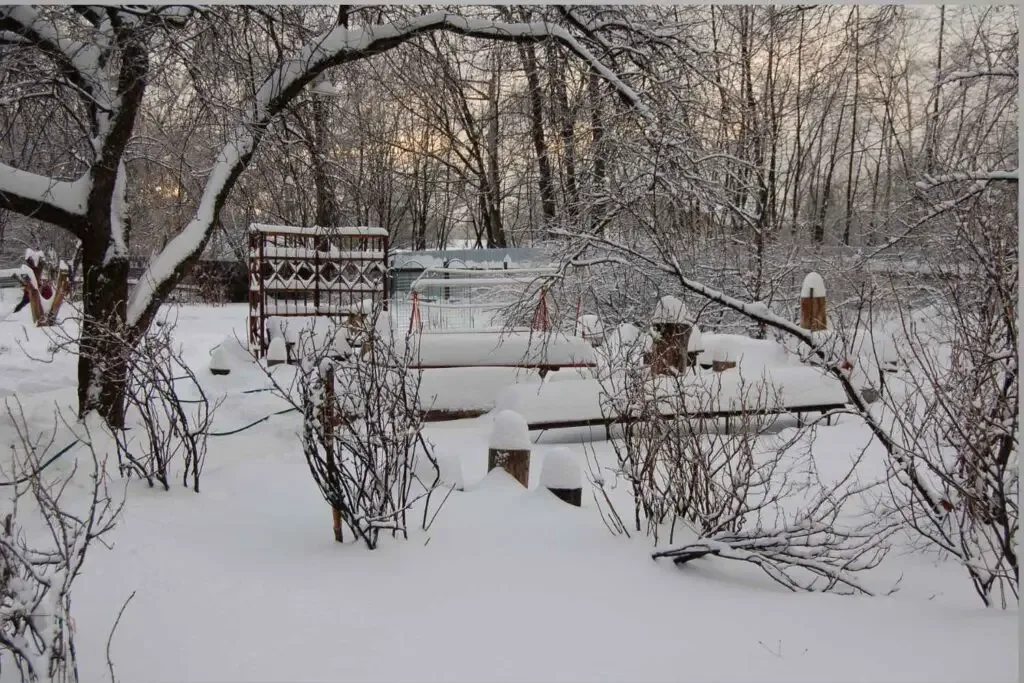
Ferns:
Landscaping with ferns adds a lush, vibrant texture to your outdoor space. Ferns are well complemented by a variety of plants and trees that thrive in shaded or partially shaded conditions.
landscaping with ferns provide a beautiful, low-maintenance addition to your woodlands garden. Native Ferns should be a foundation for your woodland garden since Ferns have been associated with woodland and natural settings for centuries and really brings in the woodland ambience.
Including ferns in a woodland garden evokes a sense of connection to nature. Fortunately Ferns can grow in a range of soil types, including those with high organic matter and moisture. They are fantastic for the tree understory with dappled light.
Ferns are also highly attractive and offer their unique style and interesting structures without much maintenance. They make a great contrast plant to other woodland flowers or provide a natural boundary or transition point where appropriate in your woodland garden design.
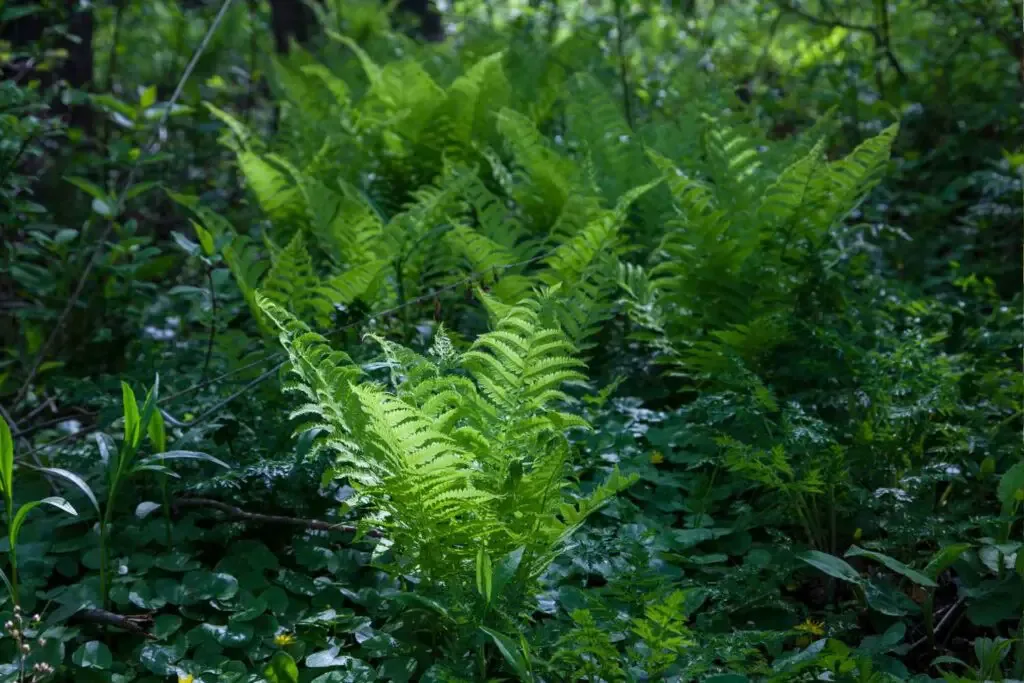
Common Woodland Garden Ferns:
- Western Sword Fern (Polystichum munitum): This fern is widespread in the coastal regions of the Pacific Northwest. It has dark green, leathery fronds and is often found in forests and wooded areas.
- Maidenhair Fern (Adiantum aleuticum): This delicate fern is native to the Pacific Northwest and is often found in moist, shaded areas. It has distinctive fan-shaped fronds.
- Lady Fern (Athyrium filix-femina): Lady ferns are native to a variety of habitats in the Pacific Northwest, including forests, meadows, and wetlands. They have lacy, light green fronds.
- Deer Fern (Blechnum spicant): Found in damp, shaded areas, the deer fern is known for its unique appearance with separate fertile and sterile fronds.
- Bracken Fern (Pteridium aquilinum): Bracken ferns are common in open areas, including meadows and disturbed sites. They have triangular fronds and can form extensive colonies.
- Licorice Fern (Polypodium glycyrrhiza): This fern is often found growing on mossy rocks and tree branches. It gets its name from the licorice taste of its rhizomes.
- Ostrich Fern (Matteuccia struthiopteris): These large ferns can add height and drama to the garden.
- Christmas Fern (Polystichum acrostichoides): This evergreen fern provides year-round interest.
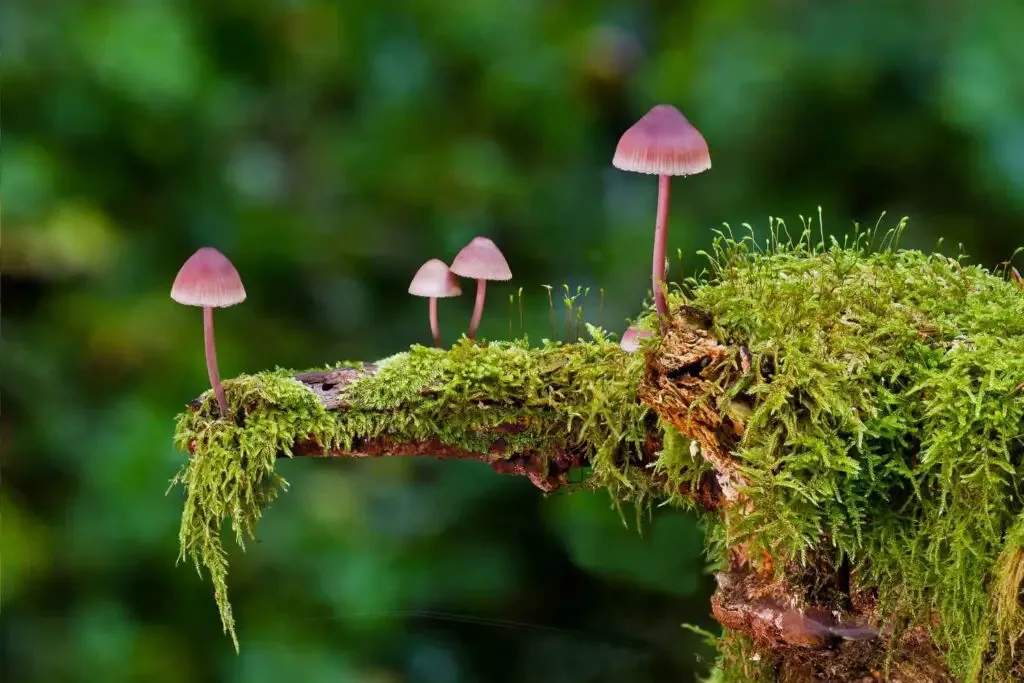
Mosses:
- Importance:
- Moisture Regulation: Mosses contribute to moisture regulation, creating a humid microenvironment.
- Habitat: They provide habitat for small invertebrates and can serve as a substrate for various fungi.
Mossy Accents:
Here you can allow nature to go wild. In moist deeply shaded areas native moss is likely to grow naturally. It’s much easier to allow that process to happen than trying to force moss where it doesn’t wish to grow. However, encourage mossy accents where you can. Moss is especially effective in shaded areas and around rocks and water features. Moss-covered rocks can add a touch of woodland enchantment.
Ground covers and Perennials For Woodland Gardens:
Native Ground Covers:
Plant native ground covers and perennials beneath trees and along pathways. Consider native plants when possible. However, before selecting any ground cover or perennial, think about the specific conditions of your woodland garden, including light levels, soil type, and climate. Consulting with local nurseries, extension services, or native plant societies will help you choose the best plants for your area and conditions.
- Importance:
- Soil Stabilization: Ground covers help prevent soil erosion, particularly on slopes.
- Habitat and Food: Many ground covers provide shelter and food for insects and small animals.
- Diversity: A diverse array of ground covers contributes to biodiversity within the ecosystem.
- Wildflowers (Various Species): Native wildflowers often serve as ground covers, supporting pollinators and providing habitat for small organisms.
- Hosta (Hosta spp.): These shade-loving perennials come in a variety of sizes and colors, adding texture to the garden.
- Bleeding Heart (Dicentra spectabilis): This spring-blooming perennial has unique, heart-shaped flowers.
- Astilbe (Astilbe spp.): With its feathery plumes, astilbe adds a touch of elegance to the woodland garden.
- Lungwort (Pulmonaria spp.): Lungwort has attractive spotted leaves and produces clusters of tubular flowers.
- Coral Bells (Heuchera spp.): These perennials are valued for their colorful foliage and small, bell-shaped flowers.
- Sweet Woodruff: Is a spring flowering ground cover that grows slowly and is easily controlled.
- Vinca Minor or Major: Commonly known as Periwinkle. This trailing ground cover is wonderful in woodland gardens. It blooms with pretty lavender flowers every spring and offers an attractive light shade evergreen covering for your tree understories.
- Wild Ginger (Asarum spp.): Low-growing with attractive foliage, native to many woodland areas.
- Allegheny Spurge (Pachysandra procumbens): A native alternative to the more commonly used Japanese Pachysandra, suitable for shaded areas.
- Foamflower (Tiarella spp.): Delicate, foamy flowers and attractive foliage, well-suited for woodland gardens.
- Canadian Wild Ginger (Asarum canadense): A low, spreading ground cover with heart-shaped leaves, native to North America.
TIP: Beware invasive species when choosing ground covers.Some Ivy, herbs, and some other ground covers can quickly overtake your path and grow out of control. This sets you up for a lot of pruning and other higher maintenance in the future.
Vines in Woodland Gardens:
Vines can be part of your woodland garden but BEWARE invasive species. English ivy, wisteria, and honeysuckle are examples of vines that will spread quickly and require a lot of pruning. Fast spreaders like these will easily get away from you. They climb and kill large bushes and trees. Keep them well controlled on isolated trellises with barriers to root spread.
But you can include vines in a woodland garden with success. And you should. Just look for proper species that add value to your design and local ecology.
When choosing vines for a woodland garden, it’s important to prioritize non-invasive species that complement the ecosystem without causing harm to existing trees or native plants. Here is a list of vines suitable for woodland gardens:
Importance:
Vertical Habitat: Vines create vertical habitat, offering nesting sites and pathways for arboreal animals.
Fruit Production: Many vines produce fruits that are consumed by wildlife.
Suggested Vines for Woodland Gardens:
- Virginia Creeper (Parthenocissus quinquefolia):A native vine with attractive foliage that turns vibrant red in the fall. It’s not aggressive and provides good ground cover.
- Climbing Hydrangea (Hydrangea anomala petiolaris):
- Known for its large, lacy white flower clusters, this deciduous vine is well-behaved and climbs without harming trees.
- Crossvine (Bignonia capreolata):
- Native to the southeastern United States, crossvine produces trumpet-shaped flowers in various colors. It’s generally well-behaved.
- Carolina Jessamine (Gelsemium sempervirens):
- A fragrant, evergreen vine with yellow, trumpet-shaped flowers. It’s native to the southeastern U.S. and is non-invasive.
- Dutchman’s Pipe (Aristolochia macrophylla):
- Known for its distinctive, pipe-shaped flowers, this deciduous vine is suitable for woodland settings and is not overly aggressive.
- Bleeding Heart Vine (Clerodendrum thomsoniae):
- A flowering vine with unique, pendulous red and white flowers. It’s generally well-behaved and adds a touch of elegance to the garden.
- Winter Jasmine (Jasminum nudiflorum):
- A deciduous vine with bright yellow, star-shaped flowers that bloom in late winter to early spring. It’s not invasive and provides winter interest.
- Sweet Autumn Clematis (Clematis terniflora):
- This deciduous vine produces masses of small, fragrant white flowers in late summer and early fall. It’s generally well-behaved.
- American Bittersweet (Celastrus scandens):
- A native vine with orange-red berries in the fall. Ensure you choose the native American species rather than the invasive oriental bittersweet.
- Trumpet Honeysuckle (Lonicera sempervirens):
- A native honeysuckle with trumpet-shaped flowers that attract hummingbirds. It’s non-invasive and well-suited for woodland gardens.
- Wild Ginger (Asarum spp.):
- While not a traditional climbing vine, wild ginger is a low-growing ground cover with unique heart-shaped leaves. It adds interest to shaded areas.
- Creeping Raspberry (Rubus calycinoides):
- A low-growing ground cover with attractive foliage and small, white flowers. It’s not aggressive and provides good coverage.
Always check with local experts or native plant societies to ensure that the selected vines are suitable for your specific region and won’t pose a threat to local ecosystems. Additionally, consider the specific growing conditions of your woodland garden, such as sunlight levels, soil type, and moisture, when choosing and planting vines.
Accents To Enhance A Woodland Garden Environment:
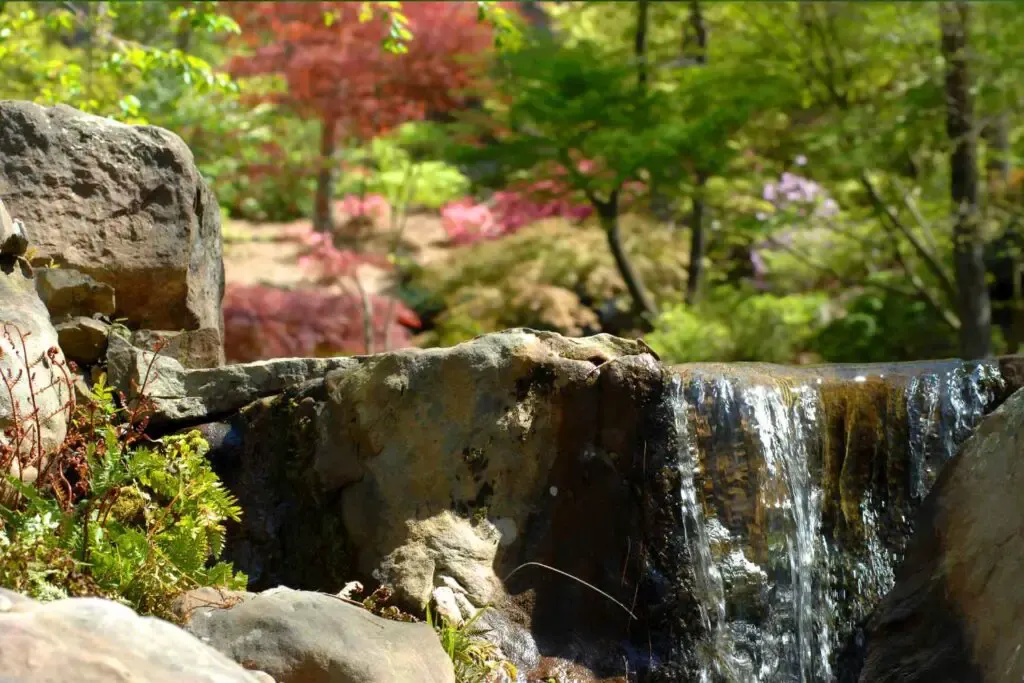
Water Feature:
Water is vital to your local animals, including bees, birds and other pollinators. And the sound of water is very restful. Place a water feature where you can see and hear it from your home, especially bedrooms. Gurgling water also makes a great white noise for sleeping.
- Integrate a water feature, such as a pond, disappearing waterfall, or a bubbling stream into a quiet area away from heavy traffic. This helps attract wildlife and contribute to the overall woodland ambiance.
A properly done water feature, like a Koi pond will provide bathing and drinking opportunities for all your backyard creatures. Some, like frogs and dragon flies will use a pond for breeding and return to it year after year. Request help when making your water feature to set it up correctly for years and year of use.
Seating Nooks:
Design small seating nooks along your garden path, near your water feature and under trees with natural materials like stone or wood. These secluded spots can offer quiet retreats within the garden.
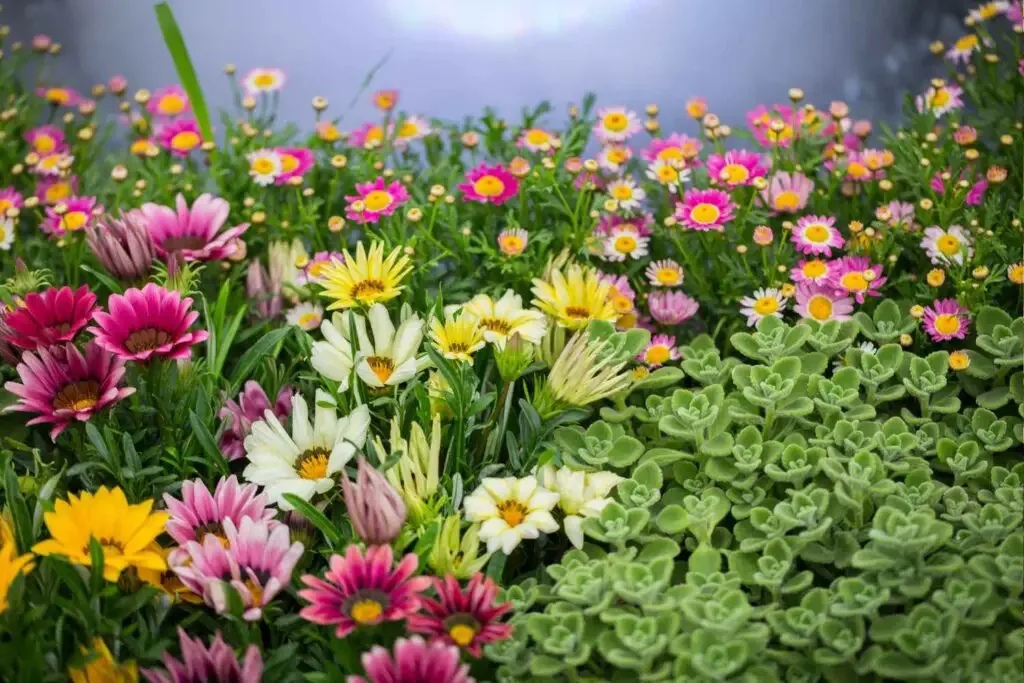
Wildflower Meadow:
- Designate a section for a wildflower meadow. This area does not have to be large and can be set near enough to the water feature for pollinators to easily find it. Include native wildflowers like coneflowers, black-eyed Susans, and butterfly milkweed.
- Bees and butterflies also love kitchen herbs like oregano, rosemary, lavender and sage. However, Herbs can be invasive so you will need to be careful or plant them in a patio with lots of natural barriers to spreading.
Habitat Piles and Natural Wood Pieces:
Create habitat piles with logs and branches in a corner of the garden. These can serve as shelter for insects, some birds and small animals. They can be incorporated into the overall design artfully and arranged as a focal point for your pleasure or hidden behind large bushes.
Bird Feeders and Baths:
Bird feeders and bird baths are great fun and will attract and support birds. But you will want to keep them away from any cats or squirrels. The feeders are often messy and can attract pests so plan carefully.
- Install bird feeders and birdbaths to attract local bird species. Place them strategically so you can see the birds. Get to know your local birds, their life cycle and basic needs so you can support them better while you enjoy them.
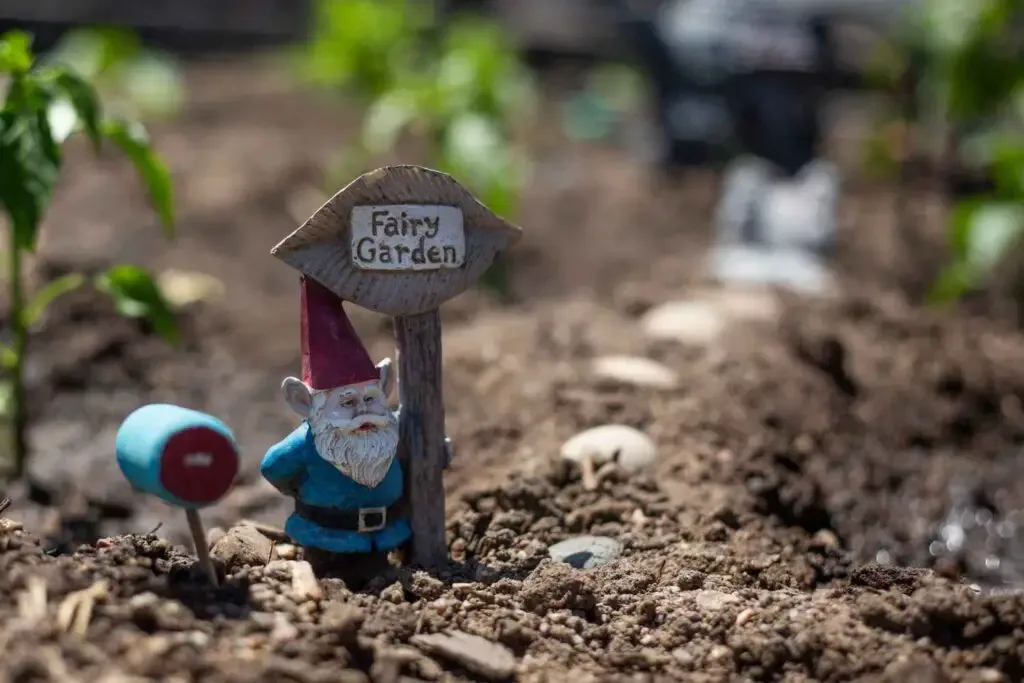
Fairy Garden Area:
Create a fairy garden area with miniature houses, paths, and whimsical elements. Use natural materials like twigs and stones for fairy-sized structures. They create a sense of storybook fantasy when used properly. Let your imagination and materials at hand lead the way here.
Added Lighting:
The purpose of outdoor lighting is to offer illumination necessary to navigate well in dark areas. However, for the best draw of wildlife keep things dark. Only Integrate subtle outdoor lighting to enhance the garden’s ambiance during the evening. Use fixtures that cast a dappled or soft glow.
Native Stone Accents:
Use native stones to create attractive accents, such as stepping stones, borders, or rock formations, to enhance the natural beauty of your woodland.
Maintenance Considerations:
Plan ahead for low-maintenance landscaping. Native plants adapted to the local climate will generally require less care than non-native species. Choose trees and bushes that don’t need a lot of pruning and cleaning up after in the Fall. Make pathways easy to tend and stay away from bushes, vines and ground covers that go wild and get out of control.
Remember to consult with local experts. Your neighborhood native plant nurseries or landscape designers familiar with your region can help you choose proper native species that are well-suited to your specific climate and ecosystem. Adjust the design based on your preferences and the specific characteristics of your yard
Follow Us:
Find us on YouTube, Instagram , Pinterest and TikTok! We love to Plant chat. We also comment, like and occasionally share your content to our daily stories. We’d love to see your plants. Share your joy in your houseplants. Happy Planting!
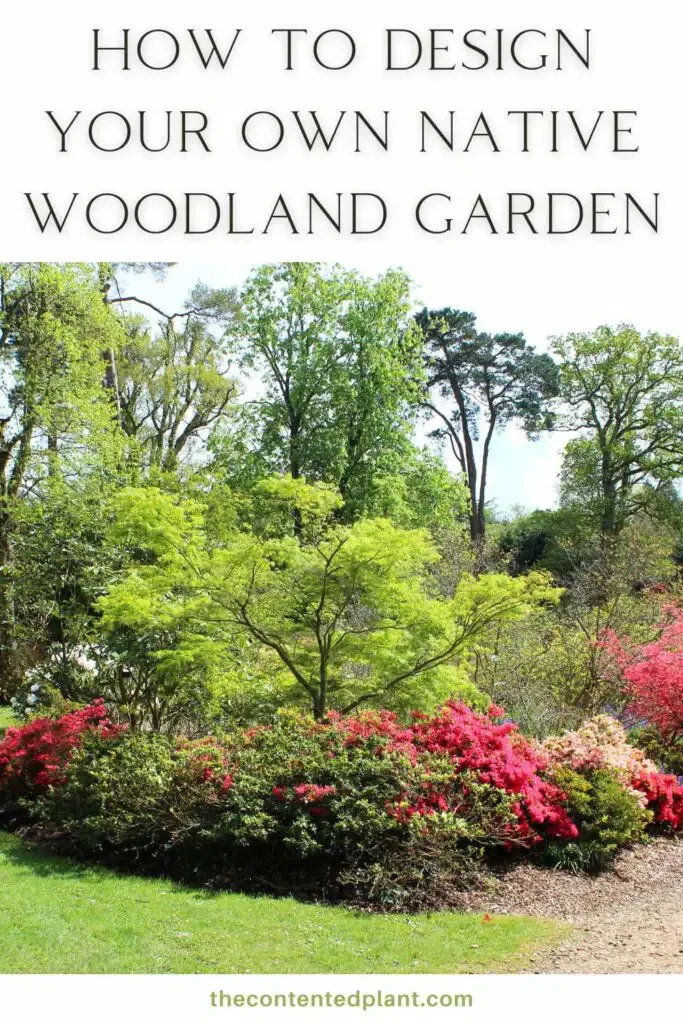

A Guide to Fertilizing Houseplants - The Contented Plant
Saturday 6th of January 2024
[…] Designing An Enchanting Woodland Garden […]